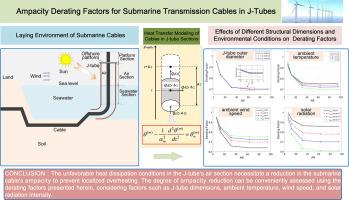J 型管海底输电电缆的载流量降额系数
IF 3.3
3区 工程技术
Q2 ENGINEERING, ELECTRICAL & ELECTRONIC
引用次数: 0
摘要
随着深海风电的发展,J 型管海底电缆的温度热点问题日益受到关注。目前,相关标准并未提供此类电缆截面的热额定值方法,仅有的研究也难以应用于实际。本研究为计算 J 型管内海底电缆的安培力降额得出了一种分析解决方案。所提出的方法不仅高效,而且易于与 IEC 相关标准相结合。首先,进行了一次室内实验来验证分析模型的正确性。随后,介绍了一个利用实际高压直流海底电缆的数值示例,该示例显示了 J 型管内电缆导体温度的升高和相应的载流量降低。采用降额系数来量化载流量降低的程度,该系数是 J 型管长度、外径、环境温度、风速和太阳辐射强度的函数。结果表明,一旦 J 型管空气部分的长度超过电缆外径的约 60 倍,输电回路的安培力就可以按照无限大 J 型管中安装的数值来计算。此外,导致电缆载流量大幅降低的因素(如高太阳辐射强度)可能会产生接近 0.6 的降额系数。本文章由计算机程序翻译,如有差异,请以英文原文为准。

Ampacity derating factors for submarine transmission cables in J-tubes
With the development of deep-sea wind power, the temperature hotspots of submarine cables in J-tubes are getting increasing attention. Currently, the relevant standards do not provide a thermal rating method for such cable sections, and the only studies are difficult to apply in practice. This study derived an analytical solution for calculating the derating in ampacity of submarine cables within J-tubes. The proposed approach is efficient and readily integrated with IEC-related standards. Initially, an indoor experiment was conducted to validate the correctness of the analytical model. Subsequently, a numerical example utilizing an actual HVDC submarine cable is presented, demonstrating increased cable conductor temperature within the J-tube and a corresponding reduction in ampacity. A derating factor is employed to quantify the extent of ampacity reduction, which is a function of the J-tube length, outer diameter, ambient temperature, wind speed, and solar radiation intensity. It turns out that once the J-tube air section's length exceeds approximately 60 times the cable outer diameter, the transmission circuit ampacity can be based on the value installed in the infinite J-tube. Furthermore, factors resulting in substantial cable ampacity reduction, such as high solar radiation intensity, may yield a derating factor approaching 0.6.
求助全文
通过发布文献求助,成功后即可免费获取论文全文。
去求助
来源期刊

Electric Power Systems Research
工程技术-工程:电子与电气
CiteScore
7.50
自引率
17.90%
发文量
963
审稿时长
3.8 months
期刊介绍:
Electric Power Systems Research is an international medium for the publication of original papers concerned with the generation, transmission, distribution and utilization of electrical energy. The journal aims at presenting important results of work in this field, whether in the form of applied research, development of new procedures or components, orginal application of existing knowledge or new designapproaches. The scope of Electric Power Systems Research is broad, encompassing all aspects of electric power systems. The following list of topics is not intended to be exhaustive, but rather to indicate topics that fall within the journal purview.
• Generation techniques ranging from advances in conventional electromechanical methods, through nuclear power generation, to renewable energy generation.
• Transmission, spanning the broad area from UHV (ac and dc) to network operation and protection, line routing and design.
• Substation work: equipment design, protection and control systems.
• Distribution techniques, equipment development, and smart grids.
• The utilization area from energy efficiency to distributed load levelling techniques.
• Systems studies including control techniques, planning, optimization methods, stability, security assessment and insulation coordination.
 求助内容:
求助内容: 应助结果提醒方式:
应助结果提醒方式:


